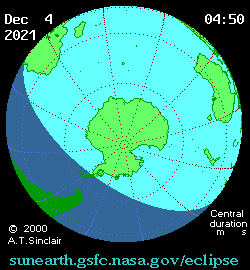Scientists prepare for rare Antarctic solar eclipseThe eclipse provides a natural laboratory for studying Earth’s upper atmospherePosted November 23, 2021
Antarctica will experience a total solar eclipse next Saturday, a rare occurrence that will give scientists insight into the behavior of Earth’s upper atmosphere. Solar eclipses happen when the Moon passes directly between Earth and the Sun, casting its shadow onto Earth’s surface and blocking out sunlight. A total eclipse occurs when the Moon completely obscures the Sun from view. Total solar eclipses don’t happen often because the Moon’s path around Earth doesn’t exactly match Earth’s path around the Sun. Total solar eclipses happen every 18 months or so on average, but most of these happen around Earth’s middle latitudes: the tropical, subtropical, and temperate regions. Eclipses near the poles are generally rare because the polar regions take up less space, so the Moon’s shadow falls on them less frequently. 
Photo Credit: Kris Kuenning/National Science Foundation.
U.S. Antarctic Program participants Joe Harrigan, Katie Burke and Allisha Ochs watch the solar eclipse above McMurdo Station on November 24, 2003.
The total eclipse on December 4 will be just the second one to pass over Antarctica this century. The last eclipse over the southernmost continent happened in November 2003, and the next one won’t be until December 2039. Researchers are taking advantage of this unusual event because it provides an opportunity to study how electricity flows through the ionosphere, a layer of Earth’s atmosphere filled with charged particles. Electrical currents are constantly flowing through the ionosphere, but they flow differently between the Northern and Southern Hemispheres, and scientists are unsure why. When sunlight dims during an eclipse, the temperature and flow of electricity in the ionosphere changes in a fairly predictable way. Researchers are planning to measure those changes during the upcoming eclipse and hope to learn more about why there are differences in electrical currents between the two hemispheres. “The eclipse is a natural experiment for us,” said Michael Hartinger, a geophysicist at the Space Science Institute in Los Angeles, California, whose team is studying the eclipse. “It's giving us the closest thing we can get to controlled conditions for understanding these asymmetries between the north and the south.” Unusually strong electrical currents in the ionosphere, such as those that happen during a solar storm, can wreak havoc on the power grid and other technological infrastructure. Understanding the intricacies of electricity in the atmosphere helps scientists better prepare for these kinds of electrical disruptions, Hartinger said. An experiment of opportunityHartinger’s team is part of an international group of researchers, including those from the United Kingdom and Denmark, who are studying the December 4 eclipse from different perspectives. This will be their first opportunity to observe detailed changes in the ionosphere from both hemispheres during an eclipse. 
Photo Credit: NASA Goddard Space Flight Center.
This animation shows the path of the total solar eclipse happing on December 4, 2021.
Electricity in near-Earth space flows along Earth’s magnetic field lines, and observations are best made near the magnetic north and south poles where the most intense currents enter and leave the ionosphere. There has been a network of ionosphere-observing instruments in Greenland since the 1990s, but a complementary network in Antarctica wasn’t completed until 2016. Hartinger and his team will use measurements from both Greenland and Antarctica to study atmospheric currents during the upcoming eclipse. The Antarctic instruments lie on the path of the same magnetic field line as those in Greenland, so researchers will be able to study currents in detail as they journey from one pole to the other. “We need to know what's happening at both ends of the field lines to really understand what's creating the electrical currents,” Hartinger said. “The special thing here is we have a network of instruments in both hemispheres and there's a lot of other supporting data we have now that we didn't have back in 2003.” Hartinger and PhD student Shane Coyle just finished servicing some of the Antarctic instruments in need of repair, so they are fully operational and ready for next Saturday’s event. Radio instruments at the three U.S. Antarctic research stations will also perform coordinated observations during the eclipse. If conditions are right, observers in West Antarctica will get the best view of the eclipse, but anyone on the continent should see at least some dimming of sunlight. The path of totality will travel in a general east to west arc from the Ronne Ice Shelf to Marie Byrd Land to the Hobbs Coast and then over the Southern Ocean. This research is supported by the National Science Foundation, which manages the U.S. Antarctic Program. NSF-funded research in this story: Michael Hartinger, Space Science Institute, Award No. 2027210 and Joseph Baker, Virginia Tech, Award No. 2027168. |
"News about the USAP, the Ice, and the People"



For USAP Participants |
For The Public |
For Researchers and EducatorsContact UsU.S. National Science FoundationOffice of Polar Programs Geosciences Directorate 2415 Eisenhower Avenue, Suite W7100 Alexandria, VA 22314 Sign up for the NSF Office of Polar Programs newsletter and events. Feedback Form |


